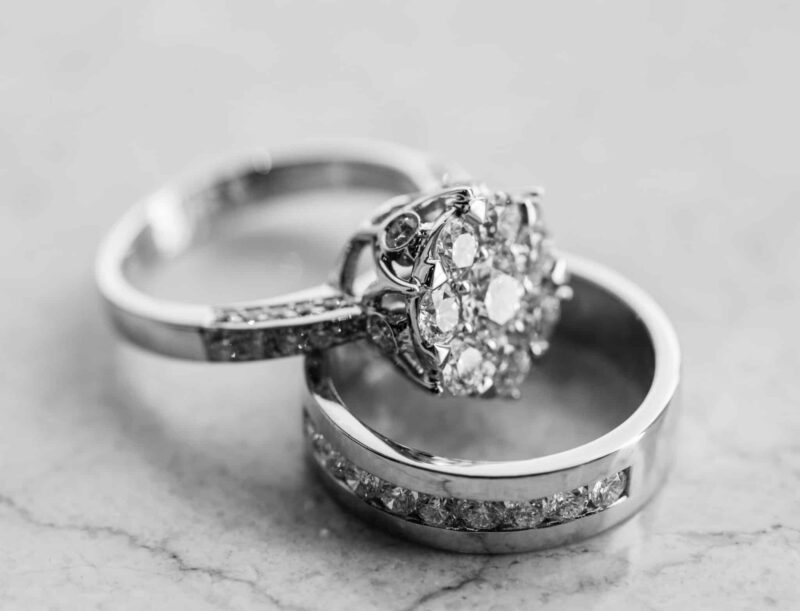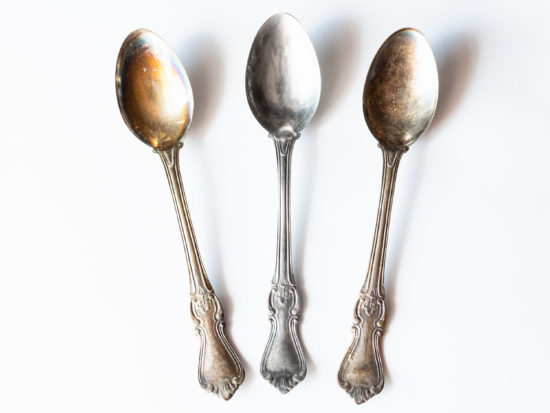What’s The Difference Between White Gold vs Silver?

By AAA
March 11, 2022
Material choices for jewelers have progressed far beyond just gold and silver, as there is now a huge range of different alloys available. These alloys offer different characteristics than pure precious metals, one of which is a variance in color. When you combine a bright yellow metal such as gold with metals of different colors, the result can be both attractive and practical.
One example is rose gold, an alloy of yellow gold and copper. Rose gold offers many of the fantastic qualities of pure gold, it’s hypoallergenic and aesthetically pleasing, as the copper color mixes with the yellow to create a highly attractive pink. Additionally, mixing copper in with gold creates a much more durable metal, as pure gold is usually too soft to use in jewelry.
Another such example of a popular precious metal alloy is white gold. White gold is very popular in jewelry and is especially common for use in wedding and engagement rings. Many people want to benefit from owning real gold, but don’t like the yellow color. In this situation, white gold offers an ideal solution. But how does it differ from silver?
White gold and silver look very similar side by side, and many people would find it difficult to tell them apart. Both are precious white metals, valuable materials with plenty of special properties. Even though they look the same, there are a few important differences that set silver and white gold apart. In this article, we’re going to explain these differences, as well as share how you can tell white gold from silver.
What is Silver?
Silver is a naturally occurring chemical element, which can be found beneath the Earth’s crust. This metal has been long valued as a precious material because of its physical and chemical properties, as well as attractiveness and monetary value. As a member of the noble metals, silver has very low reactivity. This makes it an ideal material for use in jewelry, as it won’t cause skin reactions.
Silver is a highly reflective metal, white in color. It’s the highest thermally conductive substance known to man and is also an incredibly effective electrical conductor. However, silver tarnishes easily, this chemical is too susceptible to oxidation to be used in delicate electronics. Silver has many uses in different industries including medicine and dentistry, but it’s most commonly known as a form of jewelry.
Sterling 925 Silver is the most popular material for silver jewelry, an alloy containing 92.5% pure silver by weight. The precious metal is usually combined with copper to make it stronger, as 100% silver is too soft for most purposes. Jewelry needs to be durable enough for everyday wear, which is why softer precious metals are alloyed with harder substances. Sterling silver offers all the benefits of fine silver jewelry while being more affordable and hardier.

White gold is a mixture of pure yellow gold and other metals that make the resulting alloy harder and give it a white color.
What is White Gold?
White gold is not a naturally occurring substance; it’s an alloy created using gold and another paler metal. The appearance of white gold is very similar to palladium, which is a naturally occurring alloy of silver and gold. However, gold is combined with a much harder metal than silver to create an attractive alloy of white color. The yellow tint of gold would still shine through in this combination, so white gold needs further processing after it’s been made into jewelry.
Another precious metal called Rhodium is used to plate white gold jewelry and ensure the icy silver color is strong. The rhodium plating is very effective and produces a beautiful white color on your gold jewelry, however, it will wear away over time. After the additional precious metal plating has disappeared, the yellow color of your white gold jewelry will be visible.
There are a number of different materials which are alloyed with gold to create white gold. One common choice is nickel, which is ideal as it has a strong white color. However, many people with skin allergies are sensitive to nickel alloys, so be careful if this applies to you. White gold can also be produced using copper, zinc, silver, palladium, and other metals. No matter what, the material should always be at least 50% pure gold.
What’s the Difference Between Silver and White Gold?
There are several key differences that set apart white gold from silver. Although these two materials look similar and serve many of the same purposes, they’re very much different on a fundamental level. If you’re making a decision between white gold and silver for a wedding ring or another purchase, it’s important to be fully informed about the different options. There are advantages and disadvantages to both metals, so don’t rush your decision.
Before we discuss the differences between white gold and silver, we must acknowledge the characteristics they share. Gold and silver are both naturally occurring soft materials that must be alloyed with a stronger metal for use, therefore both white gold and silver jewelry are alloys. The choice between these two metals comes down to your personal specifications, as both of them are an excellent choice. With that said, we’re now going to outline the 6 most important differences you need to know about between silver and white gold.
Difference #1: Composition
Of course, white gold and silver are composed primarily of two different materials. The most important material in each is the precious metal; in this case either silver or gold. Fine metal is alloyed with other materials to create both white gold and silver, and it’s this alloy metal that we’re comparing. As the other primary material in a piece of jewelry, the metal chosen to create an alloy is a vital component. This material can decide the color, value, and skin sensitivity level of an item.
There are several different types of white gold, which differ depending on the other metals used. An alloy of gold, silver, and copper is one of the best ways to produce white gold, as this creates a material that is hypoallergenic and durable. Fine gold alloyed with nickel is a more popular way to create white gold, but nickel can cause skin reactions so it may not be suitable for some. Manganese and palladium can also be used to add a white color to gold metal.
White gold cannot be created only by mixing pure gold with a paler metal. Although this is effective at dampening the hue, yellow tones are still visible at this stage in the process. That’s why, after the jewelry has been created, white gold is plated with another precious metal called rhodium. Rhodium is also hypoallergenic so presents no health issue, and is a very pale and bright white color. Plating white gold with rhodium compliments its color excellently, giving a final product that is made from gold but is pure white in color.
Fine silver, which is the 100% pure form of the metal, is soft and malleable like gold. It also cannot be used alone to create jewelry, so is alloyed with stronger materials for durability just like gold and white gold. Copper, nickel, and zinc are common alloy metals to create silver, and depending on the quantity used they may cause allergic reactions. Sterling silver is 92.5% pure silver and is the most common form of silver used to make jewelry.
The difference in composition between silver and white gold is small but still important. One vital element which always remains is the material used to make the alloy; if you have certain metal sensitivities then you should double-check what was used. Both wite gold and silver san contain nickel, zinc, and copper as alloys. White gold also may contain other precious metals to contribute to the color, a feature silver does not need.
The fact that rhodium is used in white gold jewelry could be viewed as a positive or a negative. On the one hand, it’s an added bonus of precious metals, as rhodium is actually the rarest on earth. Rhodium is hypoallergenic and has many other fantastic properties so it might be good to own. On the other hand, silver needs no additional help to achieve its color or finish. Only a small amount of alloy is needed for durability; other than that, the metal stands alone.
Difference #2: Purity
There is no set purity a piece of sterling silver or white gold jewelry can carry. However, there is a limit on how much precious metal you can use. Due to constraints on durability, at least some proportion of a precious metal piece of jewelry needs to be made from base metals. Without, the fine gold or silver would be too soft to hold its shape and could be easily damaged.
The standard for sterling silver is 92.5% purity, a millesimal fineness of 925. However, it’s possible to buy much finer silver, in fact up to 99.99% pure silver can be used to make jewelry. That’s because silver is a naturally occurring element, so it could in theory be refined all the way to perfection. There are many benefits to owning purer precious metals, including a better store of value.
White gold is a man-made alloy, it doesn’t exist in the natural world. Similar substances such as palladium do occur naturally, but these still retain the yellow color of gold. Because we have to combine gold with other whiter metals to achieve white gold, there is a maximum purity level which is possible. If you were to raise the concentration level of white gold further, it wouldn’t be white anymore- simply another gold alloy.
It’s only possible to reach 21 karats in white gold, a millesimal fineness of 875. Given that the standard for sterling silver is 925, we can see that there’s a significant difference. If you’re okay with 875 parts out of a total one thousand being made up of precious metals, then white gold can satisfy your needs. However, if you don’t want to buy a piece of jewelry at less than 90% purity, silver might be a better choice.
Difference #3: Durability
We’ve established how important the alloy metals are when it comes to the differences between silver and gold. Without using base metals in the construction of fine jewelry, it would be far too delicate for everyday wear. The use of nickel, zinc, copper, and other materials are vital to the production of wearable and usable products. All alloys are created with durability in mind, but there are varying levels of effectiveness.
Pure silver jewelry will easily tarnish, as well as scratch, bend, and distort. The metal is too soft for this purpose, which is why sterling silver is a much more popular choice. When silver is mixed with another metal it becomes much stronger, and won’t damage as easily. Additionally, tarnish is easier to remove and restoration is less of an issue. The exact durability of silver depends on its fineness, with lower percentages of fine metal being stronger.
White gold is in general more durable than other forms of yellow gold because more of the metal must be alloy. Lower karat white gold is much stronger than fine silver, as it has a high percentage of base metals. The metal itself is more resistant to scratches than silver. However, the rhodium plating is the weak point of a white gold piece. We all know that plated jewelry isn’t the most durable, and this thin plating will wear away over the years. Additionally, rhodium will show scratches much more easily than both unplated white gold and silver.
Difference #4: Maintenance
All jewelry must be well cared for, no matter the materials or composition. While you need to ensure special attention is given to all of your jewelry, there might be a difference in the care needed between silver and white gold. Silver, just like copper, bronze, and brass, is subject to oxidation. This metal is highly susceptible to a chemical reaction between oxygen, humidity, and the surface of the silver.
Tarnishing is a common sight on silver, it can look like a mild discoloration or deep black pitting. Over time, it can lead to a dark layer called patina on the surface of the metal, which can ruin sterling silver jewelry. There are many different easy ways to clean silver at home and remove this tarnishing effect. However, this increased maintenance and care is not something everyone is willing to devote to a piece of jewelry.
White gold is much easier to keep than silver, as gold cannot oxidize or tarnish. The only upkeep required for white gold jewelry is the occasional cleaning and it will maintain its luster well. There’s no polishing necessary for white gold jewelry. However, as the rhodium plating wears away on your item, you may notice the yellow metal begins to shine through. White gold can need replating every few years, whereas silver can last forever when cared for.
Difference #5: Appearance
While both of these white metals are technically the same color, they do have a difference in appearance. Silver has a brighter shine than white gold, it’s more reflective and can be more attention-grabbing. This can be seen as an advantage or a disadvantage, depending on the type of jewelry as well as your own personal preferences.
For example, some people think silver is a poor choice for engagement rings, as the high-shine surface may not look good against a diamond. In this case, the slightly more reserved white gold may complement the gemstone better. On the other hand, sterling silver is a better choice for earrings and other everyday pieces.
Difference #6: Cost
The unavoidable stand-out difference between white gold and silver is the price. Even if you buy 100% fine silver, the cost would not come near to the same white gold product at only 50% purity. Gold, in essence, is much more valuable than silver, so jewelry made using gold will always cost more. If you need attractive and durable jewelry on a budget, silver is a perfect choice. If you’re looking for a luxurious item for a special occasion, white gold could be the winner.

If you see white or gray tarnish on the surface of the item, it is made of silver.
How To Tell White Gold from Silver
White gold and silver look very similar and can be difficult to tell apart if you don’t know what to look for. Here are a few easy ways you can tell the difference between silver and white gold:
- Look for the rhodium plating: If you see any telltale signs of yellow poking through, chances are a piece of jewelry is made from white gold.
- Check out this shine: As we mentioned, silver shines much brighter than white gold. In comparison, one metal will seem much more dull and subdued than the other.
- Look for tarnish: Any white or gray tarnishing or discoloration, it’s probably silver.
- Hallmarks: Stamps are often placed on jewelry to tell you exactly which metals are contained. White gold uses the same hallmarks as regular gold, so a karat or K indicates the item is this metal. Silver can feature a number denoting fineness (eg 925) or letters such as STER or STG.
White Gold Vs. Silver: Which is Better?
There’s no single winner in the fight between silver and white gold, as each person must make their own decision. If you’re looking for a wedding band, a white gold ring could be the perfect choice as a valuable but understated accessory. However, this option is not very budget-friendly and may not be worth the price tag. Sterling silver will last a lifetime if you care for it, but it can also tarnish easily and need regular polishing. Both choices offer a soft metal alloyed with a harder material to create an attractive yet durable and scratch-resistant product.

